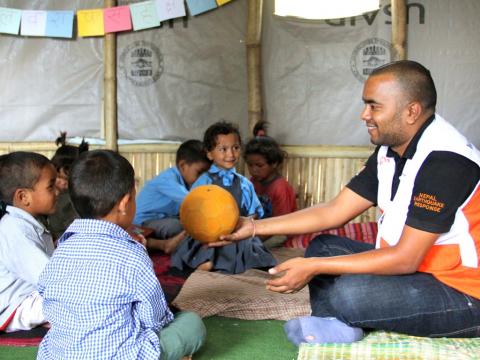Aid worker’s diary: There’s more work to be done

I was inside the Kathmandu coliseum together with other World Vision colleagues. I was playing a football game for the Association of International NGO sports event.
Suddenly, a big tremor turned our world upside down.
I saw the ground moving like waves. The rumbling sounded like thunder, followed by screams of people. The buildings and houses started to collapse. It was like watching a movie. Even now, remembering that scenario still scares me.
With a sinking heart, I knew then that the devastation from the earthquake would be massive.
I suddenly thought about my family. My wife, parents, and siblings live on the opposite side of Kathmandu. I tried to call them but the connection was down. A few hours later, I was relieved to learn that they were all safe.
It’s hard to remember how many more tremors came after the first big tremor. All I could remember was that the earthquake alarm kept going off followed seconds later by more shaking and rumbling.
I am no stranger to earthquakes in my country but, it was by far the strongest I’ve experienced.
It was the saddest day in Nepal. I wish it never happened, and I hope it will never happen again. For me it was a miracle that nothing bad happened to me.
My worries were overwhelming, but I told myself, now I’m safe, what should I do next?
As a humanitarian worker, I felt the urgency to do something. This was my first time responding to a disaster, but in spite of the chaos, I was called to help my brothers and sisters in Nepal. They needed food, water, shelter, and medical assistance.
I have taken the role as the National Education Manager in the World Vision Nepal Earthquake Response. One of our interventions is to provide safe learning spaces for children to continue their schooling.
We have close coordination with the government and I see the importance of working with them. We talk with the Ministry of Education officers, teachers, parents and even children.
It’s a tough job because the majority of schools in the country collapsed. It’s difficult to reach many of the affected places. We still fear aftershocks and landslides. It’s not easy, but my team is not giving up.
Like a football game, I see this response as teamwork. The government couldn’t do this alone or World Vision or the community people themselves. We also need donors to support our projects. We need one another to finish the goal.
Every child is the heart of World Vision’s response. I’m grateful for the smiles of the children inside the temporary learning shelters, they are inspiring me to keep going.
Even before the quake, Nepal was one of the most vulnerable countries in the world. The children and families certainly need all the support they can get for relief and recovery in the coming days.
About the author | Parash Malla is the National Education Manager of World Vision Nepal Earthquake Response. He’s been working with World Vision for three and a half years. Edited by Crislyn Felisilda, World Vision Nepal Earthquake Response